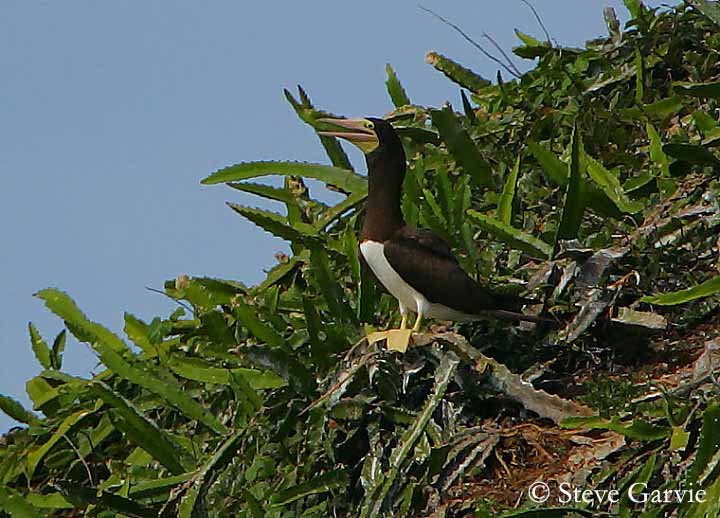
Brown Booby
Sula leucogaster
Suliformes Order – Sulidae Family
BIOMETRICS:
Length: 71-76 cm
Wingspan: 137-145 cm
LONGIVITY: up to 24 years
DESCRIPTION:
Brown Booby is smaller and slimmer than gannets, with longer tail.

Adult has distinctive sharp demarcation between brown foreparts and white remainder of underparts, and centre of underwing. It has dark head, breast, mantle and tail. White belly is cleanly separated from dark breast. Underwing is white with dark border. Bill is large, yellow and pointed. Feet and legs are yellow.
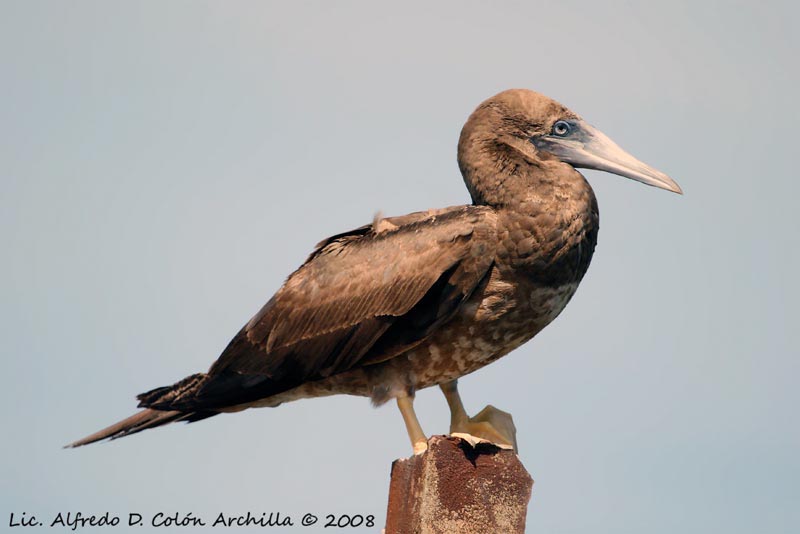
Juveniles are dark brown, with little or no contrast between breast and belly.
Immature has a similar plumage to adult, with belly slightly paler than breast.
Subadults show white on belly and sharp line of contrast with darker neck.
Sexes are distinguishable by face, bill and legs colour. These parts are yellow in females, and greyish green in males, which have a bluish throat.
VOICE: SOUNDS BY XENO-CANTO
Brown Booby’s typical calls are given at colonies. They are harsh grunts and honks (by females and young), and high, sibilant whistles (by males).
HABITAT:
Brown Booby is found in mapped marine range all year. In fact, it refers to nearly offshore islands. We can find it in rocky islands and surrounding waters, also inshore waters of mainland coasts, less often offshore waters. It winters at sea over a wider area.
RANGE:
Brown Booby is casual up Atlantic coast to Nova Scotia, and in California and the Southwest. Breeding area apparently mapped for mainland Egyptian and Red Sea coasts.
BEHAVIOUR:
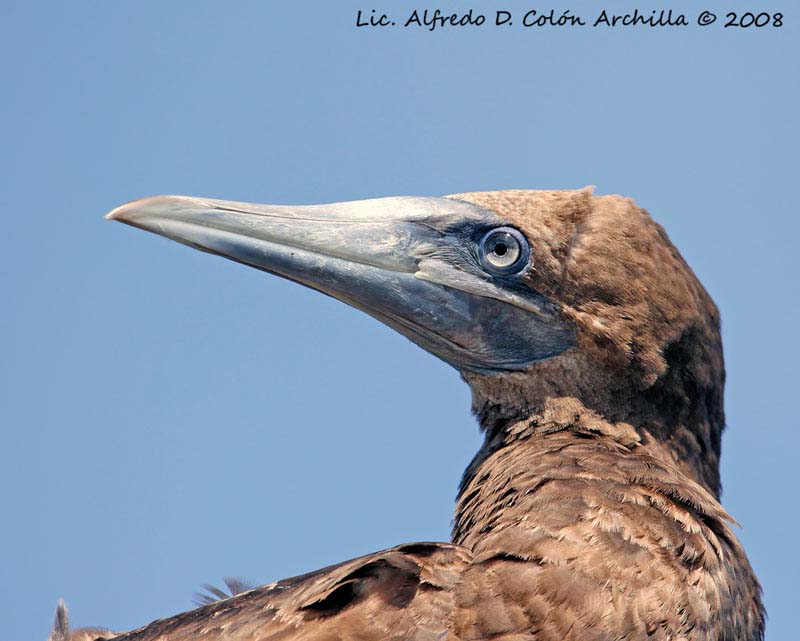
Brown Booby feeds by plunge-diving from great heights, at much shallower angle than gannets, and will even catch flying-fish on the wing. It may pursue its prey underwater. Air sacs under the skin cushion the impact with the water. It dives head first. Usually it forages near shore often within 80 km of breeding grounds. Brown booby is a solitary feeder, during daylight hours.
If they are alarmed, parents defend eggs and chicks very strongly. Male or female remains on the nest while threatening intruder.
Brown booby pairs may remain together over several seasons. They perform elaborate greetings rituals.
FLIGHT:
Brown Booby flies with faster wing beats than gannets. They have powerful and agile flights. They are particularly clumsy in takeoff and landings. To take off, it has to run on the water. When they are on the wing, but no fishing, boobies often flap and glide in lines close to the surface of the waves. On land, they are dependant on a strong wind for takeoff from an elevated perch.


REPRODUCTION:
Brown Booby breeds in colonies. Nest is located on the ground. It’s a shallow depression surrounded by twigs or vegetation, algae, and feathers. Nests are whitened with guano, and sparsely decorated with twigs, rope, string and other flotsam.
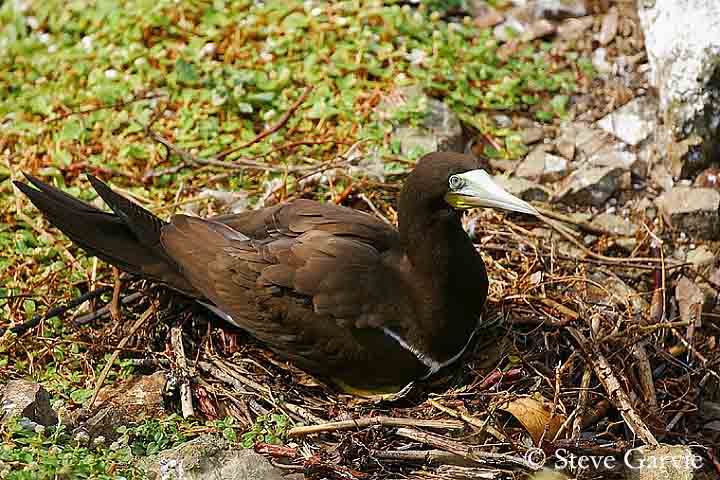
Female lays 2 chalky white eggs. Female lacks brood patch and instead incubates with feet. Both parents share incubation, changing all the 12 hours. Incubation lasts about 43 days. First egg hatches several days before the second, and the first chick ejects the second from the nest shortly after hatching. Chick is fed by parents once every 17 hours. It fledges when it’s 85 to 103 days old. Parents take care of it during one or two months.
DIET:
Brown Booby feeds on squid and flying fish.
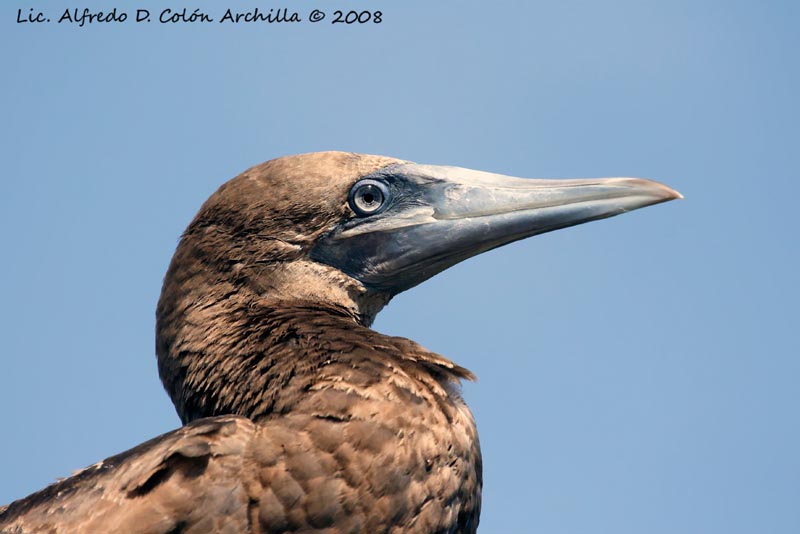
PROTECTION / THREATS / STATUS:
Frigatebirds often harass boobies, chasing them and forcing them to disgorge their prey which they catch on wing.
Pollution by oil is a threat very important for Brown booby and other seabirds.
Fr: Fou brun
All : Weißbauchtölpel
Esp : Piquero Pardo
Ital: Sula fosca
Nd: Bruine Gent
Russe: Бурая олуша
Sd: Brun sula
Texte de Nicole Bouglouan
Photographs of the young bird by Alfredo Colón
Puerto Rico Wildlife
Photographs of the adults by Steve Garvie
RAINBIRDER Photo galleries
Sources:
HANDBOOK OF THE BIRDS OF THE WORLD vol 1 by Josep del Hoyo-Andrew Elliot-Jordi Sargatal - Lynx Edicions - ISBN: 8487334105
All About Birds (Cornell Lab of Ornithology)
What Bird-The ultimate Bird Guide (Mitchell Waite)
Wikipedia (Wikipedia, The Free Encyclopedia)